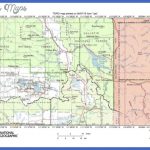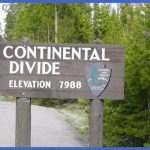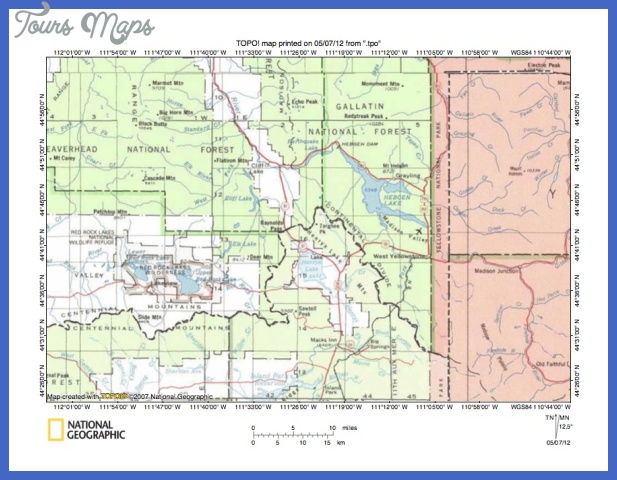Driving between Old Faithful and West Thumb, you twice pass signs identifying the Continental Divide. This makes it dicult to understand the concept of the divide or to visualize where the water is going. Maps show the Continental Divide as a thin line crossing irregularly from the park’s western boundary to leave the park near the southeast corner. What does this line represent? A divide is a geographer’s term for the topographic boundary between adjacent drainage basins or watersheds. Runoff from precipitation that falls on one side of the divide will find its way into one stream system; on the other side of the divide, surface runoff discharges into another stream system. The Continental Divide, (also known as the Great Divide) is the main watershed boundary of the North American continent. As shown in Figure 3, the divide separates areas that drain to the Pacific Ocean (green) and the Atlantic Ocean (lighter green). The area around Old Faithful Village drains Figure 3.
Map of stream flow directions and the Continental Divide. to the Atlantic Ocean via the Firehole River, a tributary of the Madison River. About 9 miles east of Old Faithful, the Grand Loop Road crosses the Continental Divide at Craig Pass, entering the watershed of the Lewis River, which flows to the Pacific Ocean via the Snake and Columbia rivers. A raindrop falling on one side of Craig Pass may be destined for Astoria, Oregon, while a drop falling a few feet away on the other side of the pass could meet the Gulf of Mexico near New Orleans. Isa Lake is situated right across this line at Craig Pass. This is a rare type of place where the top of the divide is actually flat enough to permit a small depression where a pond can form. Looking at the lake, you would think that the water from its southwestern outlet would flow to the Pacific and that from the northeastern outlet to the Atlantic, but this is not so. In this area the Continental Divide doubles back on itself and the road crosses it again, as you can see from the sketch. Using the old name, continental watershed, might make it easier to visualize.
With contributions by Linton A. Brown This high point on the road is called Craig Pass, named for the first tourist to cross the pass on the new road in 1891. From near Craig Pass, logs to build Old Faithful Inn were cut in the winter of 1903-4 and dragged down on sledges. The grade descending northeastward from Isa Lake was so steep in the early days of the first stagecoach road that drivers dubbed it Corkscrew Hill. According to Lee Whittlesey’s book Yellowstone Place Names, drivers enjoyed terrifying the dudes by rushing down this narrow and tortuous hill. Since that time, realignment has reduced the grade so much that you hardly notice the hill. 10.5/8.9 0 DeLacy Creek Trail-head opposite the parking area. DeLacy Creek Trail leads through forest and meadow south 3.5 miles (5.6 km) to the shore of Shoshone Lake, and connects with trails around that lake and along Lewis Lake channel to Lewis Lake and the South Entrance road. During most of the summer, it may be hard to keep your boots dry. Parallel deep tracks show heavy use by hikers and fishermen. Walter W. DeLacy, for whom the creek was named, was an army captain and civil engineer who passed through this part of future park territory in 1863 with a party of prospectors. Shoshone Lake was called DeLacy’s Lake for a time, in honor of his discovery that it is part of the Snake River drainage, not of the Madison River drainage, as previously believed. 10.8/8.6 ©(11) S DeLacy Creek picnic area on a short side road. 11.1/8.3 Shoshone Point turnout for a view of distant Shoshone Lake. The Teton Range about 50 miles (80 km) away may also be seen on a clear day. In 1914, here on the Grand Loop Road, a stagecoach robber stole more than $1000 in cash and jewelry from 165 passengers.
This time (unlike after other similar incidents) the robber was caught and served time in prison. He was Edward Trafton, a notorious horse thief and robber. Shoshone Lake can be reached only by hiking, riding horseback (trailhead at 4.2/15.2), or paddling a canoe up the Lewis River from its neighbor, Lewis Lake or on skis in winter. Shoshone is the second largest lake in Yellowstone and sports a major geyser basin near its western shore. Before it was called Shoshone, this large lake bore the name Madison Lake and then the names of several men who named it for themselves. Finally, Prof. Frank Bradley, chief geologist of the 1872 Hayden Expedition to Yellowstone, decided it should be named for the American Indians who frequented it. The Shoshoni tribe their name probably meaning grass house people lived in the area between the mountains of Wyoming and the present state of Oregon and as far south as Nevada. The Grand Loop Road crosses the east summit (at 8521 ft/2597 m) before reaching the next crossing of the Continental Divide.
15.3/4.1 Continental Divide (8391 ft/2558 m). This is the east side of the Continental Divide’s loop. Though it’s more than 100 feet (30 m) higher than Craig Pass, this point lacks a name. Now you’ve left the Columbia River tributary area (see the map in Understanding the Continental Divide). About 1 mile (1.6 km) to the southwest of this point, old maps showed an unnamed lake, later a Two Ocean Pond. Although old-timers claimed to have seen this lake (and to have fished it) as early as 1915 and as late as 1938, recent maps made from aerial photos do not show it. Was it a transient meltwater pond or a shallow lake that became a meadow? It remains a mystery. 15.6/3.8 0(14) S© Divide picnic area (also called East Divide) on the left (north). 18.7/0.7 Near a major curve there is parking on both sides of the road for a panoramic view of Yellowstone Lake. This spot was called Lake View as early as the 1890s. Between then and now the lodgepoles grew tall but then burned, allowing us to see lake and mountains in a 180° arc once again.
Understanding the Yellowstone Continental Divide Photo Gallery
Maybe You Like Them Too
- Top 10 Islands You Can Buy
- Top 10 Underrated Asian Cities 2023
- Top 10 Reasons Upsizing Will Be a Huge Travel Trend
- Top 10 Scuba Diving Destinations
- The Best Cities To Visit in The World




